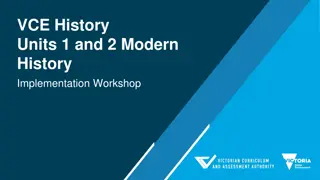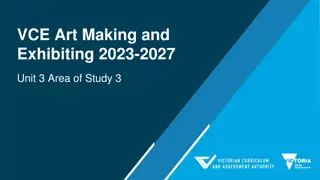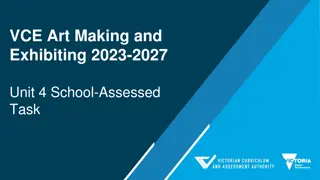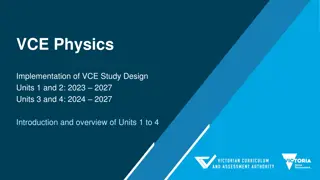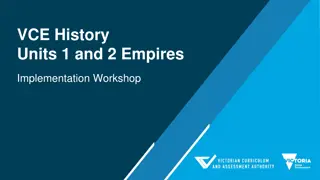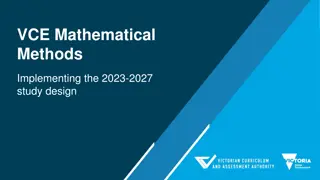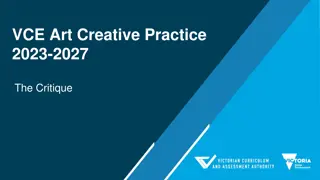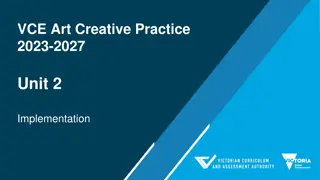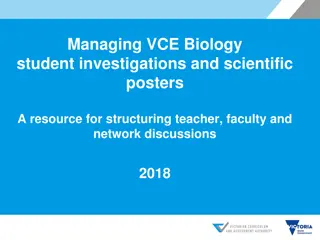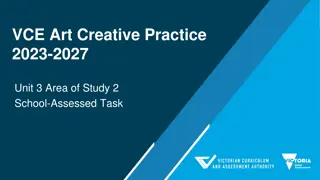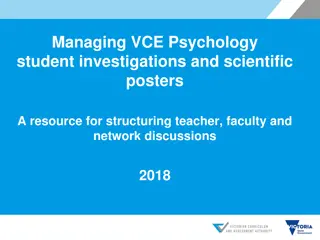VCE Art Creative Practice Unit 4 Overview
The presentation covers the features of Art Creative Practice Unit 4 School-Assessed Coursework, including an overview of Area of Study 3, teaching ideas, assessment ideas, and study specifications such as research, experimentation, interpretation lenses, and visual language. Students will engage in project-based learning, experiential learning, and inquiry learning to refine and resolve their artworks, utilizing various lenses to analyze and interpret creative practices. The study emphasizes the investigation of art elements, principles, forms, contexts, influences, and contemporary artists' work.
- Art Creative Practice
- School-Assessed Coursework
- Creative Practice Research
- Interpretation Lenses
- Visual Language
Download Presentation

Please find below an Image/Link to download the presentation.
The content on the website is provided AS IS for your information and personal use only. It may not be sold, licensed, or shared on other websites without obtaining consent from the author. Download presentation by click this link. If you encounter any issues during the download, it is possible that the publisher has removed the file from their server.
E N D
Presentation Transcript
VCE Art Creative Practice 2023-2027 Unit 4 School-Assessed Coursework
Art Creative Practice Unit 4 School-assessed coursework Overview This presentation will cover: Features of Art Creative Practice Overview of Unit 4 Area of Study 3 Teaching ideas Unit 4 Area of Study 3 Assessment ideas School-assessed Coursework
Art Creative Practice Study specifications: The Creative Practice research and investigation experimentation and development refinement and resolution reflection and evaluation. Inquiry learning Experiential learning Project based learning
Art Creative Practice Study specifications: Interpretive Lenses Through Making and Responding The Structural Lens informs the analysis and interpretation of an artwork, and its relationship with the artist and viewer or audience, through the investigation of the use of art elements and art principles, and the application of materials, techniques and processes. It also considers the stylistic qualities and symbolism evident in the artwork, and the context in which artists work and in which artworks are presented or viewed. Structural Lens The Personal Lens informs the analysis and interpretation of an artwork through the investigation of the personal feelings, beliefs and life experiences of the artist, viewer or audience. Personal Lens The Cultural Lens informs the analysis and interpretation of an artwork through the investigation of social, historical and cultural influences and representations. Cultural Lens
Art Creative Practice Study specifications: Study Terms Art elements Art principles Art forms Contexts Critique Influences and inspiration Visual language Body of Work Contemporary artists and artworks
Art Creative Practice Unit 4: Interpreting, resolving and presenting artworks and the Creative Practice Project based and inquiry learning Refinement and resolution of a Body of Work Use of Creative Practice and Interpretive Lenses Research the practices of historical and contemporary artists to inform the student s art practice. Area of Study Content summary Assessment On completion of this unit the student should be able to document their use of Creative Practice and present a critique to inform the refinement and resolution of a Body of Work. School-assessed Task Area of Study 1 Documentation and critique of the Creative Practice On completion of this unit the student should be able to use the Creative Practice to resolve and present a Body of Work. Area of Study 2 Resolution and presentation of a Body of Work On completion of this unit the student should be able to compare the practices of historical and contemporary artists, and use the Interpretive Lenses to analyse and interpret the meanings and messages of selected artworks. School-assessed Coursework Area of Study 3 Comparison of artists, their practice and their artworks
Art Creative Practice Unit 4 Outcome 3 Task requirements Each of the Interpretive Lenses can be applied to the analysis and interpretation of all artworks to varying degrees. In this area of study, students draw on specific aspects of each of the lenses to support and provide depth to their analysis and interpretation. Students must: research at least one historical artist, their practice and their artworks, and at least one contemporary artist, their practice and their artworks compare the practices of the selected artists apply all three Interpretive Lenses to analyse and interpret the meanings and messages of at least two artworks by each artist source evidence to support their interpretation and point of view.
Art Creative Practice Unit 4 Area of Study 3 Big Planning Ideas Introduce and revise the use of the Interpretive Lenses at the start of the year so that students could address the Key Knowledge and Key Skills of Unit 3 and Unit 4 Outcomes 1 & 2. Revise the three Lenses separately. Focus on: o what identifies each lens o what evidence is discussed for each o the language that would be used when applying each lens. Using a range of artworks to illustrate the characteristics of each lens and how to apply them to interpretation is useful for students.
Art Creative Practice Unit 4 Area of Study 3 Big Planning Ideas Once students understand what to look for in an artwork and what evidence to provide when applying an Interpretive Lens to the interpretation of an artwork, they are better able to apply this knowledge to the interpretation of their own artwork/s and trials as well as the work of other artists. Students can choose which artists they want to study as long as one is a traditional artist and one is a contemporary artist.
Art Creative Practice Unit 4 Area of Study 3 Big Planning Ideas Cover one traditional and one contemporary artist in detail with the class. This directs the conversation and allows students to share their opinions. This provides the teacher with the opportunity to give immediate feedback to students regarding their application of the lenses. Seek clarification from the students regarding their response, or ask for evidence from the artworks. This reminds students to provide evidence in exam situations. It also allows their peers and the teacher to build on their observations and opinions, providing further options that could be considered. Students can choose to research these two artists further or select alternative artists.
Art Creative Practice Unit 4 Area of Study 3: Comparison of artists, their practice and their artworks On completion of this unit the student should be able to compare the practices of historical and contemporary artists, and use the Interpretive Lenses to analyse and interpret the meanings and messages of selected artworks. Outcome 3 The research of artists and artworks can start with a designed question or prompt based on a common theme or personal point of view about a series of artworks that the student has selected. A definition of contexts is provided in the Terms used in the Study on page 17. A context could be selected as a starting point Learning activities can be structured around inquiry based questions about the visual language used by artists Explore the components of the Creative Practice using Inquiry learning. Look at the key words in each component and how they would lend themselves to inquiry learning Use the Interpretive Lenses to structure an inquiry. Students could select the questions in the Lenses as a basis for their research. Learning structure ideas
Art Creative Practice Unit 4 Area of Study 3: Comparison of artists, their practice and their artworks Key knowledge practices of historical and contemporary artists meanings and messages of historical and contemporary artworks the use of evidence from artworks to support analysis and interpretation the use of the Structural, Personal and Cultural Lenses to analyse and interpret historical and contemporary artworks resources to support the research of selected artists and their artworks art terminology used in the discussion and comparison of the practices of artists and their artworks
Art Creative Practice Unit 4 Area of Study 3: Comparison of artists, their practice and their artworks Key skills compare the practices of historical and contemporary artists analyse, interpret and compare meanings and messages of historical and contemporary artworks use a range of resources to compare the practices of historical and contemporary artists, and to analyse and interpret their artworks apply the Structural, Personal and Cultural Lenses to the analysis and interpretation of the meanings and messages of artworks substantiate the analysis and interpretation of artworks with evidence from the artworks and other sources use appropriate terminology and comparative language in the analysis, interpretation and comparison of the practices of artists and their artworks
Art Creative Practice Unit 4 Area of Study 3 Teaching and Learning Ideas Refer to the explanation of the Interpretive Lenses in the Study Design and in the Support Material on the VCAA website, for guidance in what each of the Interpretive Lenses are, how to apply them, and possible ways of introducing them to your students.
Art Creative Practice Unit 4 Area of Study 3 Teaching and Learning As a class, create a literature review to gather trustworthy sources about your artists. Seek authentic, reliable articles, journals, authors and websites. Write a brief overview of the relevance of the source to the life and work of the artists and include the link. Collate this for class use Make a Venn diagram of the artists to look at similarities and differences of the artists Play a game with a classmate where one argues why the artists are similar, and one argues why they are different. Make cards with reproductions of works by both artists. Group them in different ways, using the Interpretive lenses. For example, group works with a similar palette, or works with a similar theme. What similarities and differences can be seen? Imagine one of the artists is looking at the work of the other. How might they respond? What would influence their viewpoint? Make a list of things that existed or happened at the time the historical artist was working, but no longer exist or happen now. How would these have influenced the way they work, and their meanings and messages? Then, make a list of things that no longer exist or happen in the life of the contemporary artist. How might this influence the way they work, and their meanings and messages?
Art Creative Practice Unit 4 Area of Study 3 Teaching and Learning John Glover and Joan Ross consider the Australian landscape from very different perspectives. Imagine that Glover could look at Ross work? What would surprise him? Why? Latoya M. Hobbs and Robert Mapplethorpe both address beauty and identity through figurative imagery. Judy Chicago and Jenny Saville deal with issues to do with the female body and feminism. Consider both artists work through a contemporary cultural lens. Eadweard Muybridge and Shaun Gladwell deal with the theme of bodies in motion. Consider the importance of technology in the work of each artist and compare the meanings and messages in their work. Keith Haring and Peter Drew use street art to communicate messages about social justice. Compare the meanings and messages of two of their artworks. Claes Oldenburg and Ron Mueck make figurative sculptures that use scale to influence meanings and messages. Consider and compare the impact of the work on audiences. William Kentridge and Aunty Marlene Gilson s projections explore ideas around colonisation.
Art Creative Practice Unit 4 Area of Study 3 Detailed learning example Use the Interpretive Lenses Comparison Templates to compare the practices of Francisco Goya and Abdul Abdullah. From this table, write an extended report. Potential Themes: Monsters War Conflict Humanity Suffering Culture
Art Creative Practice Unit 4 Area of Study 3 Detailed learning example: Artworks Francisco Jos de Goya y Lucientes (Goya) Abdul Abdullah Selected works Selected works Yard with Lunatics, 1793-93 oil on tin plate You See Monsters, 2014, C Type print Hasta la Muerte, 1799, etching with drypoint and aquatint, Bride I, 2015, C Type print Through You, 2017 oil on canvas Charles IV of Spain and His Family, 1801, oil on canvas The Wedding (Conspiracy to Commit), 2015 C Type print For We Are Young And Free, 2017, Manual embroidery
Art Creative Practice Unit 4 Area of Study 3 Assessment You must decide on the conditions under which the task will be conducted: This task is worth 30 marks and constitutes 10 per cent of the study score for Art Creative Practice. In selecting the assessment task/s, be aware of your cohort, timing, and where this task sits in relation to teaching Unit 4. The questions for student responses must allow the students to address all the key knowledge and skills for the Outcome therefore they must be structured so students can demonstrate their knowledge of artists, their practice and artworks. Students must apply relevant aspects of the Interpretive Lenses across each of the selected artworks to interpret and compare meanings and messages.
Art Creative Practice Unit 4 Area of Study 3 Assessment
Art Creative Practice Unit 4 Area of Study 3 Preparing for the task Structural Lens: Compare the use of art elements and principles in each artwork. Compare the materials, techniques and processes used by each artists. How do these influence the messages and meanings in the artworks? Have they change, according to the time and place that they were used? How does this influence the messages and meanings in the artworks? Materials, Techniques and Processes Signs and Symbols Meanings and messages Artist 1 Artist 2 Similarities Differences
Art Creative Practice Unit 4 Area of Study 3 Preparing for the task Personal Lens: Did the artist(s) work in isolation, or collaboratively? How has this influenced the work? Does the artist(s) have specific beliefs that are relevant to the work? Have the life experiences of the artist(s) influenced the work? How? Do the specific beliefs or life experiences of the audience affect their response to the works? How? How would a contemporary audience have responded to the historical works? Collaboration/working with artisans/ audience Audience point of view/context Individual beliefs, values, philosophies Artist 1 Artist 2 Similarities Differences
Art Creative Practice Unit 4 Area of Study 3 Preparing for the task Cultural Lens: How have the time periods in which the artists worked influenced them? How is this evident? Does a contemporary audience interpret the works differently to the original audience? Why? Do the artists make work that responds to political/social/cultural context in which they work? How is this evident? Have economics influenced the artists? Did they have access, or have they used found/repurposed materials? Does the gender/background of the artists impact how the artwork was created and/or the meaning and messages? Do the practices of the artists provoke shock or disgust? Why? How do these factors contribute to engagement and communication of meaning? Ethnicity, religion, beliefs, values, traditions Location, political, social context Cultural identity artist/audience Artist 1 Artist 2 Similarities Differences
Contact Dr Kathryn Hendy-Ekers Curriculum Manager Visual Arts, Visual Communication Design and Media E: Kathryn.Hendy-Ekers@education.vic.gov.au T: 9059 5147 M: 0438471513




